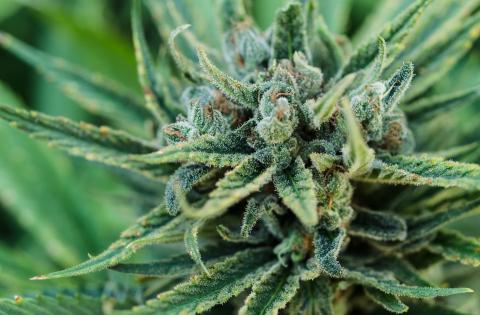The hazy status of recreational marijuana sales in Ohio

Listen to this Episode
A day before recreational marijuana became legal in Ohio, Hamilton city council took a vote, unanimously deciding to ban those sales within its city limits for at least six months.
The southwestern Ohio city isn’t alone.
In the days and months following the passage of Issue 2, local governments have taken similar votes in suburban and rural communities all over the state, from Fairfield to Ashland, Xenia to North Olmstead.
The details differ depending on the place — sometimes the prohibitions are for several months, others have no prescribed end date. Some places already allow medical marijuana sales, others have banned that too. Some seem open to the idea of eventually allowing for recreational sales, others less so.
But regardless, the bans address many of the same concerns and anxieties.
Why so many local bans?
Barbara Wilson is a spokesperson for West Chester Township, a suburb north of Cincinnati which passed a 360 day moratorium on recreational weed sales in December.
“There is a pattern of communities opting out at the beginning because it's uncertain and they don't know what to expect."
Jason Erkes, Cresco Labs
She said the temporary moratorium is needed to give the city time to better understand the current law and to adjust its zoning regulations accordingly.
“Throwing the door open to the establishment of these commercial operations: does that mean we have cannabis sales on every corner?” Wilson asked. “Does that mean every convenience store can sell cannabis? If you just allow it to happen with no rules or regulations, you can't go back and change it later.”
City officials across the state echoed her sentiment.
“There are so many things that are still up in the air to be resolved,” said councilmember Gwen Brill of Fairfield at a December council meeting. “I want to be certain what the citizens really want in the city. Do you really want a dispensary here?”
In other communities, like Ashland, the moratoriums are an extension of local legislation that already bans medical marijuana dispensaries.
“This legislation would once again reaffirm that we would not allow the commercial growth or dispensing or dispensaries within the city of Ashland,” said the city’s mayor, Matt Miller, at a January city council meeting.
Many city officials also say they’re waiting for more guidance from the state.
In December, the Ohio Senate passed a bill that would make substantial changes to the current law, including raising the marijuana tax rate. But months later, that legislation remains stalled in the Ohio House.
Federal, state and local laws — who gets the final say?
Marijuana remains federally illegal.
However, the federal government has historically relied on state and local officers to enforce their own drug laws. If those laws change, the federal government can’t force local police to prioritize federal law over state law.
So, as more states decriminalize and legalize weed, marijuana-related arrests have dropped. In 2022, the FBI reported police arrested about 227,000 people for marijuana offenses. That’s down from about 870,000 arrests in 2007.
Ohio has now joined the ranks of states that have legalized recreational pot, but the statewide law has some local limitations.

“[Municipalities] don't have the authority through Issue 2 to usurp the ability of individuals to possess or consume or grow marijuana,” said Kent Scarrett, executive director of the Ohio Municipal League. “But they can regulate the business side of it.”
Scarrett said the Ohio constitution guarantees cities and townships the right to home rule, and that applies to marijuana sales.
“Generally, the philosophy is, a better government works the best when people are closest to it,” Scarrett said. “And that is best reflected in local government because they have direct influence on how their communities work.”
Still, some of the communities banning recreational weed sales are located in counties that voted to legalize it.
Ohio dispensaries forge ahead, expect sales to rise
Regardless of local bans, Ohio dispensaries are preparing for local sales to rise.
“There is a pattern of communities opting out at the beginning just because it's uncertain and they don't know what to expect,” said Jason Erkes, the chief communications officer for Cresco Labs, which operates over 70 dispensaries across eight states, including a handful in Ohio, plus a grow facility in Yellow Springs.
He’s confident some of those communities will come around.
“When they see that there is no change whatsoever, and the community right next door that embraced it has all this tax revenue coming in and they're able to buy new computers, new fire trucks, put in new parks and playgrounds, they're like, ‘Hey, wait a minute, we want some of that tax revenue, too.’ And they're quickly changing their minds,” Erkes said.
So Cresco Labs is amping up production and preparing to open new locations across the state.
“What we've seen around the country, as states have gone through this medical to recreational conversion process, is a mass influx of people,” he said, “hundreds and hundreds of people wanting to take advantage of this new, open marketplace for cannabis.”
Still, it’ll be a while until you can buy that weed for fun anywhere in Ohio, regardless of whether your local community has a ban in place. Unless lawmakers act, the Division of Cannabis Control doesn’t plan to begin issuing permits for recreational marijuana sales til September.
9(MDYwODMwNTczMDE2ODk5NTExNDAyNzM5Ng000))
- Home
- Schedules
- TV
- TV
- Local TV Programs
- Business | Life 360 with Kristi K.
- Toledo Stories
- To The Point with Doni Miller
- Listening with Keith Burris
- Ideas & Insights
- WGTE Presents
- BL360: Northwest Ohio Innovation Consortium
- Magic of the Old West End
- Freedom Means Never Surrender
- I&I: The Random Factor
- FF: National Cherry Festival
- TTP: Moms Demand Action For Gun Sense in America
- Watch Live
- Radio
- Education
- Community
- Support
- About
- Donate


